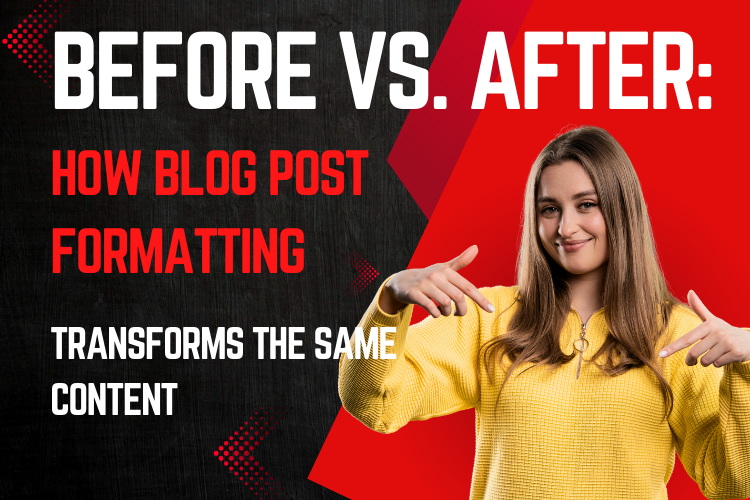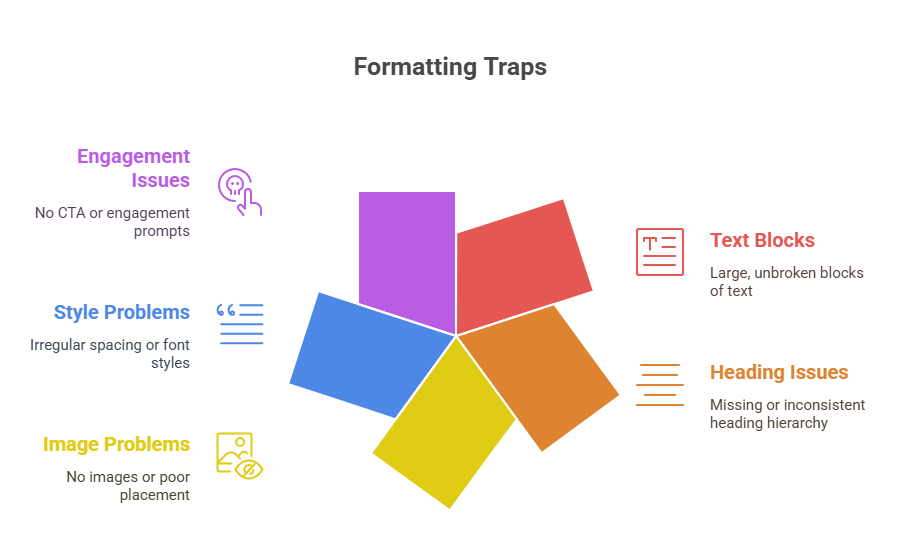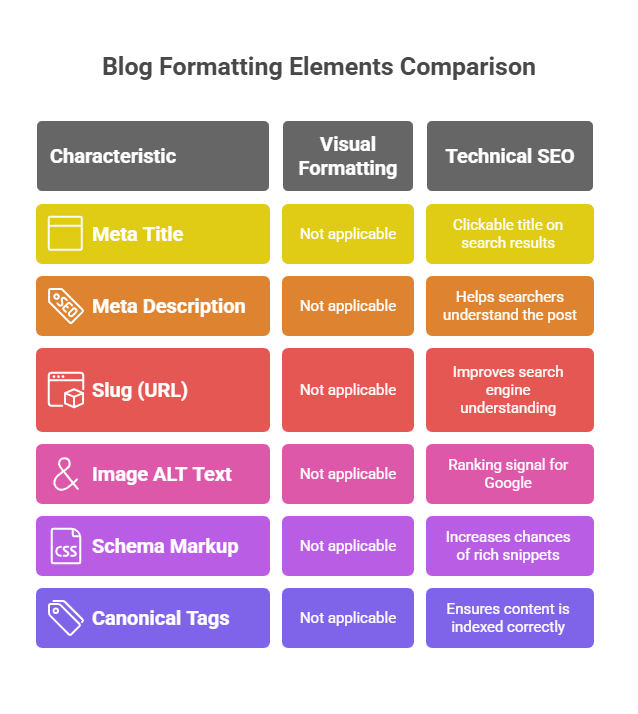
When it comes to publishing content online—whether on a personal blog, company website, or business resource hub—how your content is formatted matters just as much as what it says.
To help illustrate this, I’ve included the same article content twice below:
- First, you’ll see it with poor formatting—lacking structure, clear headings, proper spacing, and visual flow.
- Then, you’ll see the same content properly formatted and published, the way your audience (and search engines) expects it.
The difference is eye-opening.
By comparing the two, you’ll clearly see why professional blog post formatting matters—not just for looks, but for better engagement, SEO performance, and user experience.
Let’s explore the difference.
Before: A Poorly Formatted Blog Post Example
What Is Blog Post Formatting?
Blog post formatting is the art and science of presenting your content in a clear, organized, and visually appealing way. It’s what transforms a plain block of text into a structured, engaging experience for your readers. It involves using proper headings (H2, H3, H4), breaking text into short paragraphs, applying bullet points, embedding images and videos, and ensuring your content is readable across all devices. But formatting goes beyond appearance—it guides your reader’s attention, improves understanding, and encourages interaction. A well-formatted post helps your audience find what they’re looking for faster and reduces bounce rates by keeping them engaged. Good formatting also supports your content’s accessibility and SEO, making it easier for both users and search engines to navigate and understand your post. In short, formatting is the bridge between great content and great performance—and when done right, it can significantly elevate the impact of every blog post you publish.
Blog post formatting refers to how your content is structured visually and technically, making it easier for readers to scan, absorb, and engage with your content. It includes:
Headings and subheadings (H2, H3, H4), Paragraph spacing, Bullet points and numbered lists, Images and ALT text, Tables, quotes, and call-to-action (CTA)
Why Formatting Matters for SEO

Search engines like Google favor content that is:
Well-structured: Clear hierarchy through H2s, H3s, etc.
Mobile-friendly: Easy to scan on small screens.
Enriched with media: Images and video increase engagement time.
Accessible: ALT text for images and semantic HTML help with indexing.
When you format your blog post properly, you increase:
Dwell time
Click-through rate
Chances of earning featured snippets
Tip: Use relevant keywords in headings to improve on-page SEO.
Formatting for Better Readability and Engagement
Readers don’t read online—they scan. Bad formatting discourages reading, while good formatting:
Helps readers navigate your ideas
Makes long posts less intimidating
Encourages social shares and comments
Here’s a visual comparison of readability:
| Feature | Poorly Formatted | Well Formatted |
| Headings | None or unclear | Proper H2, H3 usage |
| Paragraph Length | Walls of text | 2–4 line paragraphs |
| Lists & Bullets | Rarely used | Frequently used |
| Image Placement | Misaligned or missing | Responsive with captions |
| CTA Visibility | Hidden | Highlighted clearly |
Key Elements of a Well-Formatted Blog Post
Structure
-Title (H1)
-Introduction
-H2 Subsections
-Conclusion & CTA
Readability
*Short paragraphs
*Bold key points
*Italics for emphasis
Visual Media
–Optimized images with ALT text
–Infographics or embedded videos
CTA
Encourage the reader to take the next step: subscribe, comment, share, or contact.
Common Blog Formatting Mistakes
Here are the formatting traps to avoid:
1. Large blocks of unbroken text
2. Missing or inconsistent heading hierarchy
3. No images or poor placement
4. Irregular spacing or font styles
5. No CTA or engagement prompts
Blog Post Formatting Best Practices (Checklist)
Here’s a simple checklist to follow before hitting publish:
- Clear H2 and H3 headings
- Relevant images with ALT text
- Short paragraphs and whitespace
- Compelling CTA at the end
- Preview post on mobile & desktop
The ROI of Professional Formatting
Investing in formatting doesn’t just look good—it delivers results:
- Higher search rankings
- Lower bounce rates
- Longer time on page
- Increased lead generation
If you’re investing in content creation, formatting is the final polish that ensures it performs.
Famous Quote on Presentation & Communication
“The way we communicate with others and with ourselves ultimately determines the quality of our lives.”
— Tony Robbins
Your blog post is a form of communication. Format it right—and it will speak louder.
Frequently Asked Questions (FAQs)
Q1. Does blog formatting really affect SEO?
Yes. Proper formatting helps search engines understand the content and improves user metrics like dwell time and bounce rate.
Q2. How many headings should I use in a 1000-word blog post?
Aim for 1 H1, and 3–6 H2/H3 subheadings to organize content clearly.
Q3. Is adding images necessary?
Absolutely. Images break text, improve engagement, and provide SEO value when optimized with ALT text.
Q4. What tools can I use to format better?
Use WordPress block editor, Google Docs, or Notion. For advanced formatting, tools like Grammarly and Hemingway App can help improve readability.
Q5. Can I outsource blog formatting?
Yes! Services like PostUploader.com help bloggers and agencies ensure their content is polished, SEO-friendly, and reader-ready.
After: The Same Blog Post with Professional Formatting
What Is Blog Post Formatting?

Blog post formatting is the art and science of presenting your content in a clear, organized, and visually appealing way. It’s what transforms a plain block of text into a structured, engaging experience for your readers.
It involves using proper headings (H2, H3, H4), breaking text into short paragraphs, applying bullet points, embedding images and videos, and ensuring your content is readable across all devices.
But formatting goes beyond appearance—it guides your reader’s attention, improves understanding, and encourages interaction. A well-formatted post helps your audience find what they’re looking for faster and reduces bounce rates by keeping them engaged.
Good formatting also supports your content’s accessibility and SEO, making it easier for both users and search engines to navigate and understand your post.
In short, formatting is the bridge between great content and great performance—and when done right, it can significantly elevate the impact of every blog post you publish.
Blog post formatting refers to how your content is structured visually and technically, making it easier for readers to scan, absorb, and engage with your content.
It includes:
- Headings and subheadings (H2, H3, H4)
- Paragraph spacing
- Bullet points and numbered lists
- Images and ALT text
- Tables, quotes, and call-to-action (CTA)
Why Formatting Matters for SEO

Search engines like Google favor content that is:
- Well-structured: Clear hierarchy through H2s, H3s, etc.
- Mobile-friendly: Easy to scan on small screens.
- Enriched with media: Images and video increase engagement time.
- Accessible: ALT text for images and semantic HTML help with indexing.
When you format your blog post properly, you increase:
- Dwell time
- Click-through rate
- Chances of earning featured snippets
Tip: Use relevant keywords in headings to improve on-page SEO.
Formatting for Better Readability and Engagement
Readers don’t read online—they scan.
Bad formatting discourages reading, while good formatting:
- Helps readers navigate your ideas
- Makes long posts less intimidating
- Encourages social shares and comments
Here’s a visual comparison of readability:
| Feature | Poorly Formatted | Well Formatted |
|---|---|---|
| Headings | None or unclear | Proper H2, H3 usage |
| Paragraph Length | Walls of text | 2–4 line paragraphs |
| Lists & Bullets | Rarely used | Frequently used |
| Image Placement | Misaligned or missing | Responsive with captions |
| CTA Visibility | Hidden | Highlighted clearly |
Key Elements of a Well-Formatted Blog Post

Structure
- Title (H1)
- Introduction
- H2 Subsections
- Conclusion & CTA
Readability
- Short paragraphs
- Bold key points
- Italics for emphasis
Visual Media
- Optimized images with ALT text
- Infographics or embedded videos
CTA
Encourage the reader to take the next step: subscribe, comment, share, or contact.
Common Blog Formatting Mistakes

Here are the formatting traps to avoid:
❌ Large blocks of unbroken text
❌ Missing or inconsistent heading hierarchy
❌ No images or poor placement
❌ Irregular spacing or font styles
❌ No CTA or engagement prompts
Blog Post Formatting Best Practices (Checklist)
Here’s a simple checklist to follow before hitting publish:
- Clear H2 and H3 headings
- Relevant images with ALT text
- Short paragraphs and whitespace
- Compelling CTA at the end
- Preview post on mobile & desktop
The ROI of Professional Formatting

Investing in formatting doesn’t just look good—it delivers results:
- Higher search rankings
- Lower bounce rates
- Longer time on page
- Increased lead generation
If you’re investing in content creation, formatting is the final polish that ensures it performs.
Famous Quote on Presentation & Communication
“The way we communicate with others and with ourselves ultimately determines the quality of our lives.”
— Tony Robbins
Your blog post is a form of communication. Format it right—and it will speak louder.
Summary Table
| Benefit of Proper Formatting | Impact |
|---|---|
| Better readability | Increases user engagement |
| Improved SEO | Boosts visibility and rankings |
| Stronger brand presence | Builds trust and professionalism |
| Higher conversions | Encourages action through CTAs |
| Mobile-friendliness | Ensures reach across all devices |
Frequently Asked Questions (FAQs)
The Hidden Side of Blog Formatting: What Readers Don’t See (But Google Does)

Great formatting isn’t just about what readers see—it also includes technical elements that work silently in the background to help your blog rank higher in search results.
Here are some of the most important hidden factors that professional blog formatting includes:
Meta Title
This is the clickable title that appears on Google search results. A properly crafted meta title with relevant keywords increases your click-through rate and relevance.
Meta Description
Though not directly used in ranking, a compelling meta description helps searchers understand what your post is about—and encourages them to click.
Slug (URL Structure)
A clean and keyword-rich slug (e.g. /why-blog-post-formatting-matters) improves search engine understanding and user trust.
Image ALT Text
Every image should include an ALT description. It’s not just for accessibility—it’s also a ranking signal that tells Google what your visuals are about.
Schema Markup
Adding structured data (like Article schema or FAQ schema) helps Google understand the context of your content and increases the chances of getting rich snippets—those enhanced search results with stars, FAQs, or images.
Canonical Tags
Ensures that your content is indexed correctly and avoids duplicate content issues if similar versions exist elsewhere.
By combining visual formatting with technical SEO enhancements, your blog post becomes far more powerful—both to human readers and to search engines.
Final Thoughts
Formatting isn’t just about aesthetics—it’s about making your content work for your reader and the search engines. When done right, it’s the easiest way to increase your blog’s impact without rewriting a single word.
If you want to focus on writing and let someone else handle the formatting, 📌 check out our blog post formatting services.




